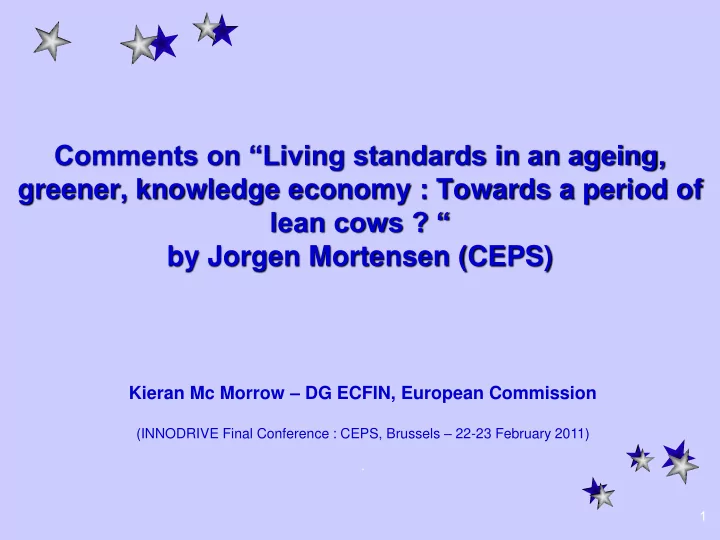

Comments on “Living standards in an ageing, greener, knowledge economy : Towards a period of lean cows ? “ by Jorgen Mortensen (CEPS) Kieran Mc Morrow – DG ECFIN, European Commission (INNODRIVE Final Conference : CEPS, Brussels – 22-23 February 2011) . 1
DG ECFIN Essential messages from paper TFP, rather that labour productivity, is the main driver of long run changes in living standards & TFP growth rates have been slowing down 2010-2030 : Lower TFP growth rates, as well as higher dependency ratios, will mean that living standards in the developed economies will only grow, on average, by ½ % per annum Skeptical that the policy approach advocated by the « Brussels consensus » of protecting living standards via productivity increases will be successful Key conclusion is that a « prolonged period of lean cows » in the post-crisis world may warrant a broader reconsideration of economic & social policies based on more sustainable consumption patterns, quality of life & social capital issues Paper calls for more research on both the links between the evolution of living standards & TFP and on the prospects for a severe shock to living standards over the coming decades 2
DG ECFIN Will the shock to EU living standards be so severe ? Yes, on the basis of current policies Effects can be lessened with appropriate policies (« Brussels Consensus » has a definite role to play) Other factors which need to be considered in assessing the likely shock to living standards 3
DG ECFIN Shock to living standards will be severe if policies do not change Euro Area & US TFP Growth Rates 1966-2020 4,0 3,5 3,0 2,5 2,0 1,5 1,0 0,5 0,0 6 9 2 5 8 1 4 7 0 3 6 9 2 5 8 1 4 7 0 6 6 7 7 7 8 8 8 9 9 9 9 0 0 0 1 1 1 2 9 9 9 9 9 9 9 9 9 9 9 9 0 0 0 0 0 0 0 1 1 1 1 1 1 1 1 1 1 1 1 2 2 2 2 2 2 2 US Euro Area 4
DG ECFIN US vs Euro Area Potential Growth Labour Input 3,0 0,6 0,5 2,5 0,4 2,0 0,3 0,2 1,5 0,1 1,0 0,0 -0,1 2005 2006 2007 2008 2009 2010 2011 2012 2013 2014 2015 2016 2017 2018 2019 2020 0,5 -0,2 -0,3 0,0 2005 2006 2007 2008 2009 2010 2011 2012 2013 2014 2015 2016 2017 2018 2019 2020 -0,4 Euro Area US Euro Area US Labour Productivity TFP Capital Deepening 1,4 2,5 1,2 1,2 1,0 2,0 1,0 0,8 1,5 0,8 0,6 0,6 1,0 0,4 0,4 0,5 0,2 0,2 0,0 0,0 0,0 2005 2006 2007 2008 2009 2010 2011 2012 2013 2014 2015 2016 2017 2018 2019 2020 2005 2006 2007 2008 2009 2010 2011 2012 2013 2014 2015 2016 2017 2018 2019 2020 2005 2006 2007 2008 2009 2010 2011 2012 2013 2014 2015 2016 2017 2018 2019 2020 Euro Area US Euro Area US Euro Area US 5
DG ECFIN Shock to living standards can be reduced with appropriate policies Shift in the conceptual framework for explaining TFP determinants Limitations of earlier models in explaining TFP growth (especially 3. New Growth Theories Institutions + Policies post-1995) based on are key drivers of TFP « Schumpeterian » creative growth 1. Neoclassical model destruction mechanisms provide a better framework (Different focus for frontier for understanding TFP vs. catching-up countries) 2. AK Models 6
DG ECFIN Need for a specific focus on TFP Enhancing Policies (Boosting the 2 key drivers of TFP : Technology & Factor Efficiency) Direct TFP Enhancing Policies 1. Action on innovation / intangible investments 4. Encouraging 2. Human (Scientific+Non- firm creation & 3.Exploitation Capital Scientific R&D) entrepreneurship of ICT Development +(Computerised Info (Resource Systems)+ reallocation) (Economic Competencies) Indirect TFP Policies (Essential Framework Conditions / Flanking Policies) 1. Sufficient 2. Effective « demand » / 3. Favourable Intellectual 4.Effective levels « lead users » to macro-economic Property Rights of competition reward successful environment (IPR) Schemes innovators 7
DG ECFIN 2. Euro Area TFP level differences (US=100) EA Hourly Labour Productivity (US = 100) EA Capital Intensity + TFP (US=100) 95,0 110,0 105,0 90,0 100,0 95,0 85,0 90,0 80,0 85,0 80,0 75,0 75,0 70,0 70,0 1997 2000 2003 2006 2009 2012 2015 2018 1997 2000 2003 2006 2009 2012 2015 2018 Euro Area TFP Capital Intensity 8
DG ECFIN Large Euro Area – US TFP level differences in ICT production & Non-ICT Market Services Euro Area TFP levels in 2005 (United States = 100) ICT Industry Total Industries Non-ICT Non-ICT (Electrical & Optical Equipment – Goods Producing Industries Market Services ICT Goods) (Telecommunications – ICT Services) 85 72 86 78 Source : EU KLEMS 9
DG ECFIN Specific hypotheses for explaining the US’s outperformance in market services Technology / Knowledge Investment Drivers 1+2+3 Total Knowledge 1. Tangible ICT 2. Human Capital 3. Intangible Investments Investments Investments Investments Factor Efficiency Drivers Inadequate Competition in EU Market Services Economies of scale in US market services 10
DG ECFIN Concluding Remarks Risk to living standards, especially in the EU, is great over the coming decades However, the situation is not without hope Policy response is crucial 11
Recommend
More recommend